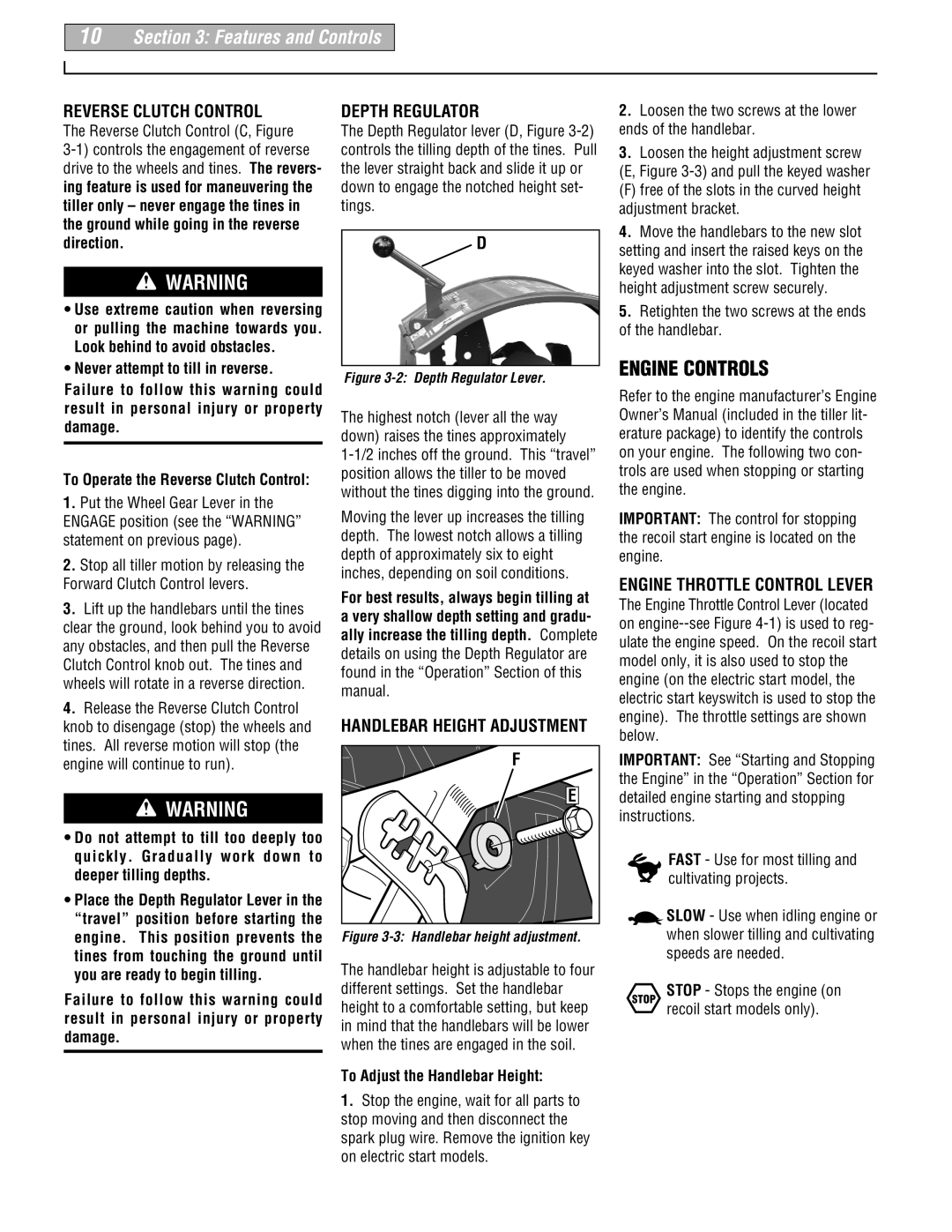
10Section 3: Features and Controls
REVERSE CLUTCH CONTROL
The Reverse Clutch Control (C, Figure
WARNING
•Use extreme caution when reversing or pulling the machine towards you. Look behind to avoid obstacles.
•Never attempt to till in reverse.
Failure to follow this warning could result in personal injury or property damage.
To Operate the Reverse Clutch Control:
1.Put the Wheel Gear Lever in the ENGAGE position (see the “WARNING” statement on previous page).
2.Stop all tiller motion by releasing the Forward Clutch Control levers.
3.Lift up the handlebars until the tines clear the ground, look behind you to avoid any obstacles, and then pull the Reverse Clutch Control knob out. The tines and wheels will rotate in a reverse direction.
4.Release the Reverse Clutch Control knob to disengage (stop) the wheels and tines. All reverse motion will stop (the engine will continue to run).
WARNING
•Do not attempt to till too deeply too quickly. Gradually work down to deeper tilling depths.
•Place the Depth Regulator Lever in the “travel” position before starting the engine. This position prevents the tines from touching the ground until you are ready to begin tilling.
Failure to follow this warning could result in personal injury or property damage.
DEPTH REGULATOR
The Depth Regulator lever (D, Figure
D
Figure 3-2: Depth Regulator Lever.
The highest notch (lever all the way down) raises the tines approximately
Moving the lever up increases the tilling depth. The lowest notch allows a tilling depth of approximately six to eight inches, depending on soil conditions.
For best results, always begin tilling at a very shallow depth setting and gradu- ally increase the tilling depth. Complete details on using the Depth Regulator are found in the “Operation” Section of this manual.
HANDLEBAR HEIGHT ADJUSTMENT
F
E
Figure 3-3: Handlebar height adjustment.
The handlebar height is adjustable to four different settings. Set the handlebar height to a comfortable setting, but keep in mind that the handlebars will be lower when the tines are engaged in the soil.
To Adjust the Handlebar Height:
1.Stop the engine, wait for all parts to stop moving and then disconnect the spark plug wire. Remove the ignition key on electric start models.
2.Loosen the two screws at the lower ends of the handlebar.
3.Loosen the height adjustment screw (E, Figure
(F) free of the slots in the curved height adjustment bracket.
4.Move the handlebars to the new slot setting and insert the raised keys on the keyed washer into the slot. Tighten the height adjustment screw securely.
5.Retighten the two screws at the ends of the handlebar.
ENGINE CONTROLS
Refer to the engine manufacturer’s Engine Owner’s Manual (included in the tiller lit- erature package) to identify the controls on your engine. The following two con- trols are used when stopping or starting the engine.
IMPORTANT: The control for stopping the recoil start engine is located on the engine.
ENGINE THROTTLE CONTROL LEVER
The Engine Throttle Control Lever (located on
IMPORTANT: See “Starting and Stopping the Engine” in the “Operation” Section for detailed engine starting and stopping instructions.
FAST - Use for most tilling and cultivating projects.
![]() SLOW - Use when idling engine or when slower tilling and cultivating speeds are needed.
SLOW - Use when idling engine or when slower tilling and cultivating speeds are needed.
STOP STOP - Stops the engine (on recoil start models only).
